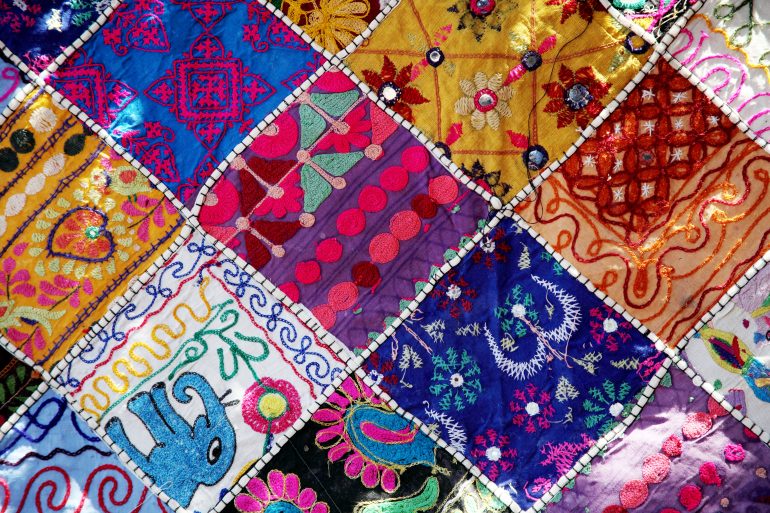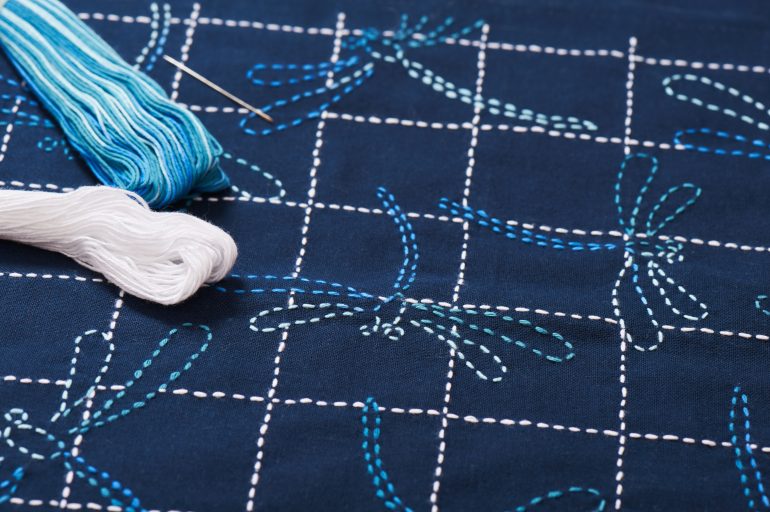Throughout the tapestry of human history, few crafts have embodied the essence of storytelling, creativity, and community as distinctly as quilting. But what is quilting? At its core, it’s the art of sewing together multiple layers of fabric to create a padded material, a practice that can be traced back far into history.
These quilts, be they utilitarian or decorative, serve as records of familial milestones, cultural narratives, or personal expressions of the quilters themselves.
Indeed with a needle, thread, and fabric, anyone can embark on the quilting adventure. So if you’ve ever asked ‘what is patchwork’ or ‘what is sashiko quilting’ or if you’ve ever wondered how to make a barn quilt, read on.
The Beauty of Quilting

A patchwork quilt. (Credit: DEV IMAGES via Getty Images)
The allure of quilting transcends its practical applications. It’s not merely about producing a warm blanket or a decorative wall hanging. So, what is quilting? To many, quilting is a meditative journey, a celebration of patience, an exercise in creativity, and an opportunity to join fellow enthusiasts. Quilting bees, once a staple in communities as a social event and a collective way to produce quilts, highlight the craft’s deep-rooted association with camaraderie and shared tales. As you learn more about this craft, you’ll realise it’s not just about making quilts – it’s about adding to a rich, global tapestry of stitched stories.
A Short History of Quilting

A stack of hand sticked quilts. (Credit: images by Karen Burns/Vintage Findings via Getty Images)
The word quilt finds its roots in the Latin term culcita, meaning a stuffed sack, bolster, or cushion. It later evolved in Middle English as quilte, denoting a mattress or cushion. Although the etymology provides a hint towards its padded nature, the history of quilting as an art form spans cultures, presenting a richer tapestry than the term might initially suggest.
Evidence of quilting can possibly be traced back as far as the Egyptian First Dynasty, somewhere between 3400 and 3000 BC. This oldest potential evidence of quilting is a representation found upon a carved ivory figure of an ancient Egyptian pharaoh. However, it’s far from certain that the sculpture shows evidence of quilting being used so far in the past.
In more modern history, in Asia, particularly in Mongolia and China, quilted garments were developed for their insulating properties, essential for the cold climates. As for quilted bedcovers or decorative pieces, one of the earliest known examples is the Tristan quilt from Sicily, dated to the second half of the fourteenth century AD. Over time, as trade routes expanded and cultures intermingled, the art of quilting spread. Each society imbued the craft with its own distinct traditions, patterns, and purposes.
In Europe, for instance, quilting became particularly popular in the Middle Ages for its use in armour as a layer of warmth and protection. Meanwhile, in North America, early settlers embraced quilting not only for warmth but also as a medium for communal bonding and artistic expression. It’s in North America where the question ‘what is a barn quilt’ is most commonly asked, but we’ll get to that shortly.
Different Types of Quilts

Japanese sashiko (Credit: MaxCab via Getty Images)
A quilt is a quilt, right? Wrong! A quilt is generally made up of three layers, two outer layers of fabric and the filling, known interchangeably as padding or batting. Almost all quilts are made up of these three layers but there are different types of quilts.
Patchwork
Before we answer the question ‘what is a patchwork quilt’, we should explain ‘what is patchwork.’ Also called pieced work, patchwork is the art of sewing together lots of geometric-shaped pieces of fabric to make one large piece. They can be as simple as lots of squares stitched together or beautifully intricate creations. Some of the most exquisite textile quilts from Europe, the Middle East and Asia are patchwork. The appliqué technique – although this was a name given to it much, much later – which refers to a needlework technique where pieces of fabric are sewn onto a larger piece to form a design or picture, can be traced back to ancient Egypt and was also found in numerous cultures across the Middle East.
What is Sashiko Quilting?
Translated as ‘little stabs’, sashiko quilting is a traditional Japanese embroidery technique introduced during the Edo period (1603—1868). It’s characterised by its simple running stitch used to create striking geometric patterns. Originally employed by farmers and fishermen to mend and reinforce fabrics, especially indigo-dyed cotton, its functional origins evolved over time into decorative designs. Today, sashiko embroidery is recognised both for its utilitarian purposes and its intricate, aesthetic patterns in the world of textile arts.
What is a Barn Quilt?

A traditional barn quilt. (Credit: Marcia Straub via Getty Images)
When is a quilt not a quilt? When it’s a barn quilt. While the tradition of quilting goes back thousands of years, the first barn quilts didn’t appear until very recently. But what is a barn quilt?
A barn quilt is a large piece of painted wood – or even a painted design directly on a barn – that mimics the appearance of a quilt. Typically, they’re square and can range in size, but are often large enough to be easily visible from a distance. While they don’t serve a functional purpose like traditional quilts, they’re a form of public folk art that celebrates quilting heritage and often reflects personal or regional stories and histories.
Any article asking ‘what is quilting’ can’t fail to mention these incredible works of art. Barn quilts are largely an American phenomenon, particularly popular in rural areas and on driving trails specifically dedicated to showcasing these artworks. The trails serve as a way to promote tourism and share the stories or history of the local area.
The barn quilt movement is often credited to Donna Sue Groves. While quilts have long been hung outside in various cultures for different reasons, Donna Sue’s idea was unique in its execution and purpose. In 2001, in Adams County, Ohio, she painted a quilt square on her family’s barn to honour her mother. This singular act snowballed, leading to the creation of barn quilt trails, which communities adopted as a way to foster community pride, promote tourism, and celebrate the art and craft of quilting.
The Final Stitch: The Timeless Tale of Quilting

Shared experience: quilting together. (Credit: RL Productions via Getty Images)
So what is quilting? To some, it’s a way of life. With its intricate patterns, historical roots, and communal ethos, it’s more than just a craft—it’s a narrative of human experience.
From ancient times to the barns of modern-day America, these stitched stories offer a glimpse into the lives, aspirations, and cultural tapestries of those who wield the needle and thread. Each quilt, whether a simple patchwork or an exquisitely elaborate tapestry, speaks a universal language of dedication and creativity. In a rapidly changing world, quilting remains a testament to the endurance of tradition.












